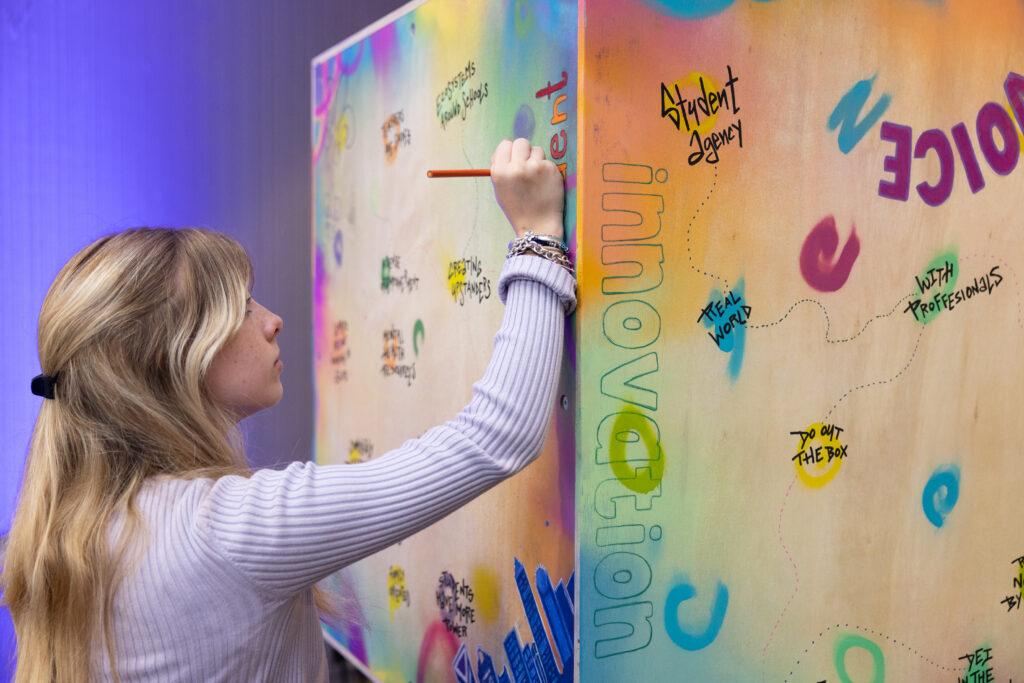Can the principles of Silicon Valley venture capitalists be applied to social problems? Meet the ‘education entrepreneurs.’
With a crack house around the corner, and dealers and prostitutes being shooed away from the grounds,Monarch Academy in the Sobrante Park section of Oakland, Calif., seems an improbable site for innovation in education. But unlike the parochial school that once stood here and closed because of poor enrollment, Monarch Academy has a waiting list of 300, after being in business for only three years. And even though many of its 334 K-5 students do not speak English and come from impoverished families, it ranked in the top 1 percent of most-improved schools in California in 2001. Reading and math scores went from near bottom to average, remarkable results in such a short period, educators say.
In some ways, it’s just like any other charter school, the popular public-private hybrids that get public money but operate independently of their districts. But there’s a key difference that helps to explain Monarch’s success—the involvement of the influential NewSchools Venture Fund, which aims to apply toK-12 education the hands-on style that venture capitalists famously brought to the world of high tech. Old-style philanthropy typically gave away large sums and then watched passively as the money was used by various nonprofits. By contrast, the VCs and their friends in “venture philanthropy” have no interest inbeing mere bystanders. Kim Smith, a cofounder of the NewSchools fund, says it’s trying to promote “scalable entrepreneurial solutions” for American education. That’s New Economy lingo for rescuing children in low-performing schools.
Funded five years ago with $20 million from a who’s who of Silicon Valley, the nonprofit NewSchools initially focused on California. Contributors included venture capitalist John Doerr, Cisco CEO JohnChambers and Netscape cofounder Jim Clark. Now it is poised to become a bigger player. Despite the bursting of the dot-com bubble, NewSchools has opened a Washington office as a base to look for East Coast innovators and new funding sources.
NewSchools, based in San Francisco, also recently created two new investment funds, one of which it hopes will launch six nonprofit charter-school chains, with as many as 100 schools in each. NewSchools has already raised about half the $50 million goal. And while NewSchools isn’t the only group trying to foster educational entrepreneurs, reform experts like Bruno Manno of the Annie E. Casey Foundation say it’s become the biggest and best known.
Doerr, who provided seed money for such companies as Sun and Netscape, got involved after state policymakers challenged high-tech types to do more than gripe about the state of American schools. “We knew that those who had applied the business model to education had by and large failed,” he says. So “wedecided to combine social entrepreneurs with risk-taking venture capitalists. We wanted to introduce into the lexicon the idea of an education entrepreneur.
“Investors “totally got” the hybrid notion NewSchools was selling, says Smith, a 35-year-old Stanford M.B.A. Adapting strategies for launching start-ups, NewSchools demands applicants go through the standard drill required by VCs, including submitting a detailed business plan. You need a good idea thatwill fill in a piece of the school-reform puzzle “not emerging on its own,” Smith says. And it has to havethe potential to make an impact on thousands of students.
Unlike traditional philanthropists like Walter Annenberg, who sprinkled $500 million over thousands of programs with mixed results, NewSchools gives projects just enough to get up and running. “We don’t want companies to need a little money from us for the rest of their lives,” Smith says. But in contrast to established venture-capital benchmarks, says Doerr, success for NewSchools is measured “in ways like how many more kids learn to read, how many go to college.”
Some of the first fund’s $20 million went to educators like Don Shalvey, who had one successful charter and dreamed of creating the Aspire chain, which now includes Monarch. NewSchools also invested in the expansion of Teach for America, which recruits college graduates to work in inner-city schools for two years—a program that Smith helped start. And it assisted in the launch of companies like New Leaders forNew Schools, a nonprofit that recruits prospective school principals.
NewSchools retains a special place in the reform marketplace because it’s also willing to fund for-profit projects. Occasionally, NewSchools itself realizes a financial gain—as it did with the sale of Learn Now Inc., which was bought by the country’s largest for-profit chain, Edison Schools. But the investors never see that money. Smith says they understand that “social returns” is all they’ll get. Any profits flow back into NewSchools.
The national movement to encourage the creation of more charters as alternatives to regular public schools is at a critical juncture. While many charters have opened, too few have kept the promise of high achievement gains in exchange for less bureaucracy. Smith and Doerr hope New-Schools’ funds will spur the movement on. They want both to expand their network of education services and to help open more charters by creating six chains, each with a different approach but all replicable and sustainable. Theywould be in clusters around the country—close enough to each other to allow founders to maintain oversightand economies of scale, but distant enough to affect multiple districts.
NewSchools, like any upstart, has its critics. San Francisco School Board president Jill Wynns, who opposes for-profit education, is wary of big chains run by private groups. “I don’t think there is anyevidence that they work better,” she says. “They’re just a big distraction.” For the parents at Monarch Academy, however, it isn’t the big picture that interests them as much as the smaller, safer school thatseems to be working. They like that Monarch requires uniforms, assesses their children frequently andkeeps students with the same teacher for two years. “My daughter enjoys the structure,” says Dana Mitchell, whose 7-year-old is an early reader. “They challenge her.” That’s the kind of return on investment NewSchools aims to be all about.


